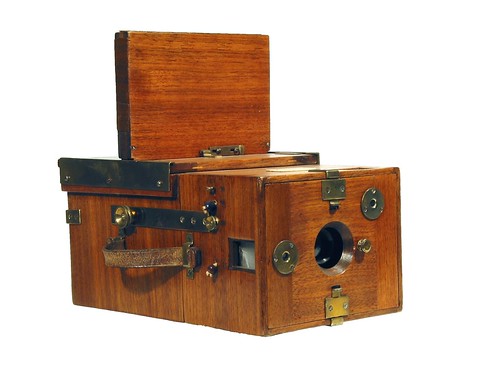Difference between revisions of "Mars Camera"
m (Rearranged some of the text. Not a falling-plate camera in the usual sense.) |
(Added ref to an example at Westlicht. Noted pull-string controls. Noted three apertures on a disc, and that only some cameras have a plate-counter) |
||
| Line 8: | Line 8: | ||
}} | }} | ||
| − | The '''Mars camera''' is a '''detective camera''' made in mahogany by [[Emil Wünsche]] of Dresden from 1889 to 1893. It contains twelve 9x12cm plates. It has a brass bound 130mm f/8 [[Aplanat]] lens and [[Shutter#rotary shutter|rotary shutter]]. | + | The '''Mars camera''' is a '''detective camera''' made in mahogany by [[Emil Wünsche]] of Dresden from 1889 to 1893. It contains twelve 9x12cm plates. It has a brass bound 130mm f/8 [[Aplanat]] lens, with three apertures in a rotating disc,<ref name=W>[http://www.westlicht-auction.com/index.php?f=popup&id=210807&_ssl=off#210807 Mars Camera serial no. 6123], sold at the [http://www.westlicht-auction.com/index.php?id=197083&acat=197083&lang=3 December 2010 Westlicht Photographica Auction] in Vienna. Several excellent photographs, showing features such as the selectable aperture disc and pull-string controls.</ref> and [[Shutter#rotary shutter|rotary shutter]], operated by pull-strings. |
| − | The Mars is a [[magazine camera]]: the plates, in metal holders, are stored in the back part of the camera body. The | + | The Mars is a [[magazine camera]]: the plates, in metal holders, are stored in the back part of the camera body, under spring pressure (there is a pull-string to relieve this pressure while changing the plate).<ref name=W></ref> The plate at the front of the magazine is in the exposing position. The wooden part projecting on top of the camera is a plate-changer. After each exposure, the camera can be turned upside-down, and the holder with the exposed plate falls into the wooden changer. Then the changer is shifted to the back of the body, where the exposed plate falls back into the plate magazine when the camera is turned right-side up again. Some examples of the Mars have a dial counter showing the number of plates exposed;<ref name=nu>[http://www.photographica.nu/mars203.htm Mars Camera] at [http://www.photographica.nu www.photographica.nu]</ref> this was perhaps a late addition or optional feature; it is absent on the example pictured here, and the one cited at Westlicht.<ref name=W></ref> |
There are [[Viewfinder#Watson finder|Watson finders]] for horizontal and vertical orientation. | There are [[Viewfinder#Watson finder|Watson finders]] for horizontal and vertical orientation. | ||
| Line 18: | Line 18: | ||
<references /> | <references /> | ||
| − | + | ||
| − | |||
[[Category:M]] | [[Category:M]] | ||
Revision as of 22:38, 29 January 2012

|
| Mars Camera 1893 image by Ron (Netherlands) (Image rights) |
The Mars camera is a detective camera made in mahogany by Emil Wünsche of Dresden from 1889 to 1893. It contains twelve 9x12cm plates. It has a brass bound 130mm f/8 Aplanat lens, with three apertures in a rotating disc,[1] and rotary shutter, operated by pull-strings.
The Mars is a magazine camera: the plates, in metal holders, are stored in the back part of the camera body, under spring pressure (there is a pull-string to relieve this pressure while changing the plate).[1] The plate at the front of the magazine is in the exposing position. The wooden part projecting on top of the camera is a plate-changer. After each exposure, the camera can be turned upside-down, and the holder with the exposed plate falls into the wooden changer. Then the changer is shifted to the back of the body, where the exposed plate falls back into the plate magazine when the camera is turned right-side up again. Some examples of the Mars have a dial counter showing the number of plates exposed;[2] this was perhaps a late addition or optional feature; it is absent on the example pictured here, and the one cited at Westlicht.[1]
There are Watson finders for horizontal and vertical orientation.
Notes
- ↑ 1.0 1.1 1.2 Mars Camera serial no. 6123, sold at the December 2010 Westlicht Photographica Auction in Vienna. Several excellent photographs, showing features such as the selectable aperture disc and pull-string controls.
- ↑ Mars Camera at www.photographica.nu